Related Research Articles

Benozzo Gozzoli was an Italian Renaissance painter from Florence. A pupil of Fra Angelico, Gozzoli is best known for a series of murals in the Magi Chapel of the Palazzo Medici-Riccardi, depicting festive, vibrant processions with fine attention to detail and a pronounced International Gothic influence. The chapel's fresco cycle reveals a new Renaissance interest in nature with its realistic depiction of landscapes and vivid human portraits. Gozzoli is considered one of the most prolific fresco painters of his generation. While he was mainly active in Tuscany, he also worked in Umbria and Rome.

Guillaume Courtois or italianized as Guglielmo Cortese, called Il Borgognone or Le Bourguignon, was a Franc-comtois-Italian painter, draughtsman and etcher. He was mainly active in Rome as a history and staffage painter and enjoyed high-level patronage. He was the brother of the painters Jacques Courtois and Jean-François Courtois.
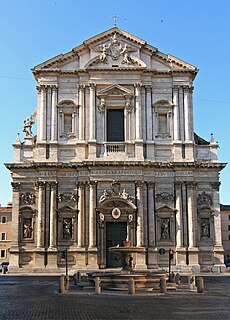
Sant'Andrea della Valle is a minor basilica in the rione of Sant'Eustachio of the city of Rome, Italy. The basilica is the general seat for the religious order of the Theatines. It is located at Piazza Vidoni, 6 at the intersection of Corso Vittorio Emanuele and Corso Rinascimento.

Pellegrino Tibaldi, also known as Pellegrino di Tibaldo de Pellegrini, was an Italian mannerist architect, sculptor, and mural painter.

Cosimo Rosselli was an Italian painter of the Quattrocento, active mainly in his birthplace of Florence, but also in Pisa earlier in his career in 1481–82 in the Sistine Chapel in Rome, where he painted some of the large frescoes on the side walls.
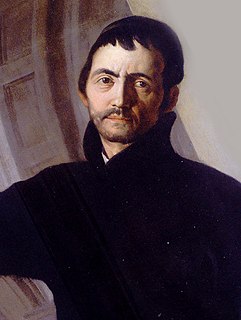
Andrea Pozzo was an Italian Jesuit brother, Baroque painter, architect, decorator, stage designer, and art theoretician.

Alessandro Tiarini was an Italian Baroque painter of the Bolognese School.

Pietro (Libertino) Liberi was an Italian painter of the Baroque era, active mainly in Venice and the Veneto.
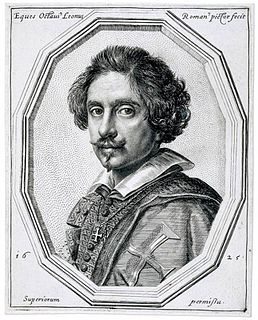
Ottavio Leoni (1578–1630) was an Italian painter and printmaker of the early-Baroque, active mainly in Rome.
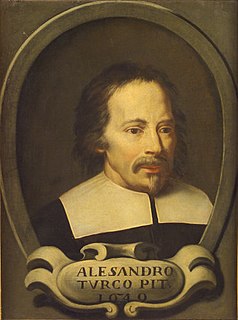
Alessandro Turchi was an Italian painter of the early Baroque, born and active mainly in Verona, and moving late in life to Rome. He also went by the name Alessandro Veronese or the nickname L'Orbetto. His style has been described as soft and Caravaggesque at the same time.
Giovanni Ventura Borghesi was an Italian painter of the Baroque period, active mainly in Rome.
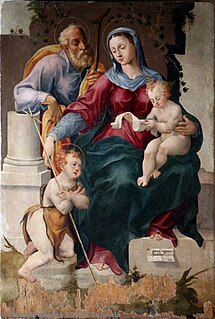
Pietro Negroni, also called Il Giovane Zingaro and Lo zingarello di Cosenza, was an Italian painter of the Renaissance period, active mainly in Naples. He was known for his altarpieces, mythological scenes and portraits.

Ludovico Gimignani was an Italian painter, who is mainly known for his altarpieces for churches in Rome.

Filippo Abbiati (1640–1715) was an Italian painter of the early-Baroque period, active in Lombardy and Turin, together with Andrea Lanzani and Stefano Maria Legnani, he was a prominent mannerist painters from the School of Lombardy. Born in Milan, he was a pupil of the painter Antonio Busca. Alessandro Magnasco was one of his pupils along with Pietro Maggi and Giuseppe Rivola. Ticozzi claims he trained, along with Federigo Bianchi, with Carlo Francesco Nuvolone. Along with Bianchi, he painted the cupola of Sant'Alessandro Martire in Milan. Abbiati also painted a St. John preaching in the Wilderness for a church in Saronno.
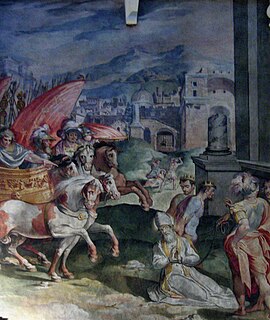
Vespasiano Strada (1582–1622) was an Italian painter and engraver of the early-Baroque period, mainly active in Rome. His biography is summarized by Giovanni Baglione.

Antonio Barbalonga or Barbalunga, also called Antonio Alberti, was an Italian painter of the Baroque period.

Norbert van Bloemen, called Cefalus or Cephalos, was a Flemish painter and draughtsman who worked mainly in Italy and the Dutch Republic. He is known for his Italianizing landscapes and genre scenes reminiscent of the style of the low-life paintings of the Bamboccianti. He also painted portraits and some history paintings.

Niccolò Franchini (1704-1783) was an Italian painter, active in Siena, depicting mainly religious canvases in a late-Baroque style. Niccolò Franchini (1704-1783) was an Italian painter, active in Siena, depicting mainly religious canvases in a late-Baroque style.

Dirck Hendricksz was a Dutch-Italian painter. In Italy he was known as Teodoro d'Errico or Dirk Hendrici. He was engaged in painting mainly altarpieces and for churches in Naples from 1574-1606. Although born in Holland, he is referred in texts as a Flemish painter.
Jacopo Siculo, also known as Giacomo Santoro da Giuliana (1490-1544) was an Italian painter of the Renaissance, mainly active in Umbria.
References
- ↑ Assoziacione Storico-Culturale Agostina. Entry on painter.